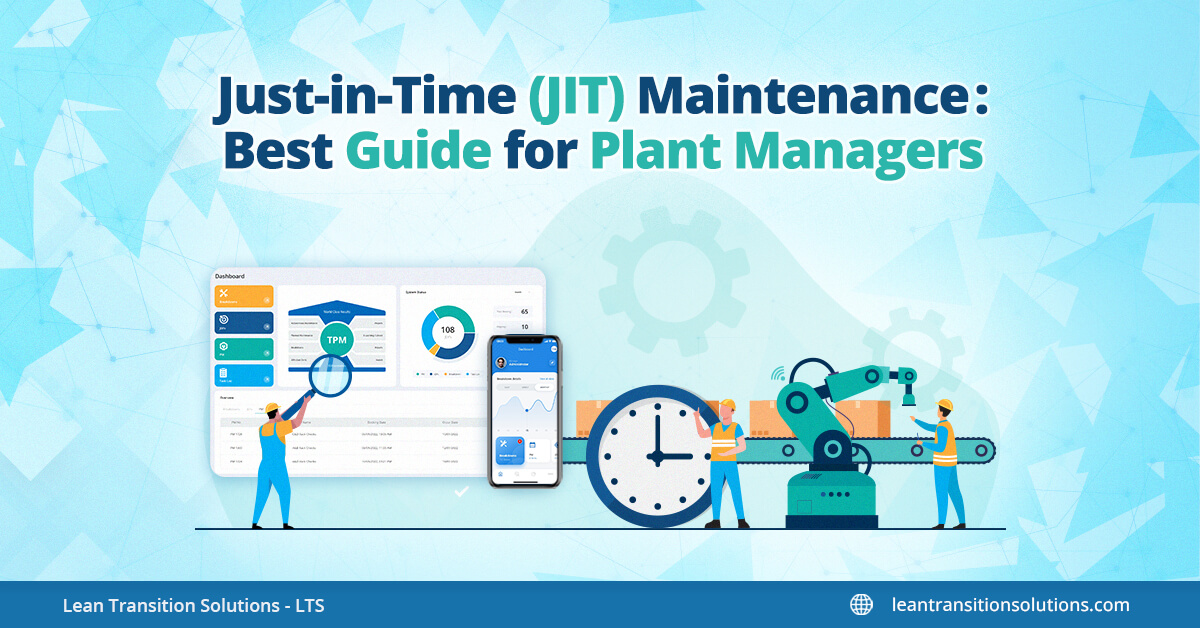What is Just in Time Maintenance (JIT)? A complete guide for plant managers
October 8, 2025
Just in Time Maintenance (or JIT Maintenance) is a maintenance strategy where tasks and repairs are performed precisely when they’re needed, based on real-time data and asset condition—not on arbitrary schedules.
At its core, JIT Maintenance borrows from the broader Just in Time (JIT) philosophy, which originated in manufacturing. That is, maintenance is performed right before a failure is likely to occur—not too early and definitely not too late.
In today’s competitive manufacturing environment, equipment downtime isn’t just an inconvenience—it can disrupt an entire production schedule, inflate costs, and erode trust with customers. Plant managers need more than a basic plan; they need an adaptable strategy that keeps equipment running at its best without wasting resources. Just in Time Maintenance offers precisely a smarter way to care for your assets, cut down on waste, and keep production lines humming.
At its core, JIT Maintenance borrows from the broader Just in Time (JIT) philosophy, which originated in manufacturing. That is, maintenance is performed right before a failure is likely to occur—not too early and definitely not too late.
In today’s competitive manufacturing environment, equipment downtime isn’t just an inconvenience—it can disrupt an entire production schedule, inflate costs, and erode trust with customers. Plant managers need more than a basic plan; they need an adaptable strategy that keeps equipment running at its best without wasting resources. Just in Time Maintenance offers precisely a smarter way to care for your assets, cut down on waste, and keep production lines humming.
Why Just in Time Maintenance matters to plant managers
As a plant manager, you’re balancing it all: production targets, budget pressures, safety, and the endless quest for uptime. You don’t need another layer of maintenance “theory”—you need a practical, proven approach that keeps your plant running smoothly and lean.
That’s exactly what JIT Maintenance promises. It’s the answer to questions like:
That’s exactly what JIT Maintenance promises. It’s the answer to questions like:
- How can I cut unnecessary maintenance costs?
- How do I align my maintenance with real equipment needs?
- How can my team stay focused on real priorities, not just busy work?
An example of Just in Time Maintenance
Imagine you’re managing a bottling plant. In the past, you’d change out the conveyor motor belts every six months, just to be safe. But sometimes, those belts still had plenty of life left, and the time and materials used for early replacement felt wasteful.
With Just in Time Maintenance, you install a small vibration sensor on the conveyor motor. It’s constantly monitoring the motor’s health and alerts your team only when vibrations rise above a certain threshold—a sign the belt is starting to wear out.
With Just in Time Maintenance, you install a small vibration sensor on the conveyor motor. It’s constantly monitoring the motor’s health and alerts your team only when vibrations rise above a certain threshold—a sign the belt is starting to wear out.
- No more changing belts too early.
- No more unplanned downtime when they fail unexpectedly.
- Maintenance happens just in time—right when it’s needed.
The principles behind Just in Time Maintenance
Just in Time Maintenance is more than a fancy term—it’s a shift in how and why maintenance happens. Here’s how it differs from traditional approaches:
- Based on actual equipment condition: Instead of relying solely on fixed schedules, maintenance is done when indicators show wear or risk.
- Minimal inventory: Parts and materials are stocked only as needed, similar to JIT inventory management in manufacturing.
- Elimination of waste: Time, resources, and money are focused only on maintenance that adds value.
- Continuous improvement: Feedback and data analysis help to finetune the process over time.
How Just in Time Maintenance differs from traditional preventive maintenance
Plant managers often ask:
“Isn’t this the same as preventive maintenance?”
Not quite! Let’s break it down:
“Isn’t this the same as preventive maintenance?”
Not quite! Let’s break it down:
| Traditional Preventive Maintenance | Just in Time Maintenance (JIT) |
|---|---|
| Based on time-based schedules (e.g. every 3 months) | Based on real-time indicators (e.g. vibration, temperature) |
| Maintenance happens regardless of condition | Maintenance happens based on actual condition |
| Often leads to over-maintenance or waste | Reduces unnecessary tasks and minimizes waste |
| Inventory for spare parts kept “just in case” | Inventory aligned with JIT inventory system principles |
| Focused on avoiding breakdowns | Focused on optimizing timing and resource use |
Key benefits of Just in Time Maintenance for shopfloor and industry
Here’s why industries across the board—whether in automotive, food processing, or heavy equipment—are adopting JIT Maintenance to rethink how they keep their production lines moving:
- Reduced downtime
Maintenance is carried out only when needed—no surprises, no excessive downtime. - Lower maintenance costs
Labour and parts are used exactly when needed, cutting unnecessary expenses. - Longer equipment lifespan
Equipment is neither overworked nor under-maintained, extending its usable life. - Leaner inventory
Like JIT inventory management, you hold only the parts you need—reducing storage costs and clutter. - Better use of workforce
Technicians focus on value-added tasks rather than repetitive, unnecessary ones. - Increased operational flexibility
By responding to actual equipment needs, your plant can pivot faster to production changes.
Key components of a successful Just in Time Maintenance program
Implementing JIT Maintenance isn’t just about changing a schedule—it’s about rethinking your entire approach to asset care. Here’s what makes it work:
- Real-time data collection
Sensors, IoT devices, and smart monitoring tools track asset condition continuously. - Predictive maintenance tools
Vibration analysis, temperature tracking, and data analytics help predict issues before they occur. - Integrated CMMS software
A good CMMS (like Titan CMMS) pulls in data, schedules tasks, and manages workflows—making JIT Maintenance possible. - Technician engagement
Operators and technicians need training to understand what to look for and how to respond. - Cross-functional collaboration
Maintenance isn’t a silo. Production, inventory, and procurement all play roles in JIT Maintenance success. - Continuous improvement culture
A lean, data-driven mindset helps teams adjust processes and fine-tune maintenance plans over time.
Steps for implementing JIT maintenance in your organisation
Switching to just in time maintenance isn’t just about tweaking schedules—it’s about building a smarter, data-driven process. Here’s how to get started:
- Assess your current maintenance practices
Look at how maintenance is currently done—what works, what doesn’t, and where waste or over-maintenance might be hiding. - Identify critical assets
Pinpoint the assets that have the most impact on your operations and are most prone to costly downtime. - Integrate sensors and condition monitoring
Install sensors, such as vibration or temperature sensors, to monitor equipment health in real-time. - Choose the right CMMS tools
Use CMMS software to organise data, automate alerts, and turn insights into clear action plans. - Set maintenance triggers
Work with your team to define clear thresholds for when maintenance should occur—no sooner, no later. - Train and involve your teams
Make sure everyone understands the benefits of just-in-time maintenance and how their role changes to support it. - Review and refine
Continuously measure results—such as reduced downtime or lower inventory costs—and refine your approach based on real-world data.
Common challenges of implementing JIT Maintenance & how to fix it
Switching to JIT Maintenance isn’t always straightforward. Here’s what plant managers often face—and how to tackle it:
- Resistance to change in existing workflows Solution: Communicate benefits and involve teams in planning.
- Data overload from sensors and condition monitoring Solution: Use your CMMS software to sort data and highlight what is actionable.
- Integrating JIT Maintenance with older equipment Solution: Start with simple sensors or manual inspections for older assets.
- Uncertainty about the ROI of JIT Maintenance Solution: Track key performance metrics—like downtime reduction and inventory cost savings—to prove the value.
- Skills gap in condition-based maintenance Solution: Provide training and support to build confidence in interpreting data and making decisions.
Meet your JIT Maintenance partner: Titan CMMS
If you’re dealing with the challenges of shifting to Just in Time Maintenance—like sorting through mountains of sensor data, making sure parts are always available, and training teams to respond faster—Titan CMMS can help you bridge the gap.
- Turn data into action
With Titan, you don’t just see data; you act on it. Real-time asset condition tracking ensures you know exactly what’s happening on your shop floor. - Get ahead with automated alerts
When sensors detect problems—like increased vibration or temperature—Titan instantly triggers alerts so you can act before minor issues become costly breakdowns. - Seamless integration with JIT inventory
Titan connects your maintenance schedules with your JIT inventory management. Parts are ordered just when needed, keeping costs low and uptime high. - Easy-to-use dashboards for your team
Titan’s dashboards are designed for busy plant managers and technicians: clear, actionable insights that make decision-making easier.
FAQs
1. Is Just in Time Maintenance only for large plants?
No. Even small facilities can start with basic monitoring tools to reduce waste and boost reliability.
2. How does JIT Management relate to JIT manufacturing?
Both aim to reduce waste and improve flow—JIT Maintenance simply applies these principles to asset care.
3. Can we use JIT maintenance with legacy equipment?
Yes! Start with simple condition checks or low-cost sensors before investing in advanced solutions.
4. Does JIT maintenance replace preventive maintenance entirely?
Not always—JIT Maintenance works alongside preventive approaches, making them more precise. JIT Maintenance is need based and preventive maintenance is time based.
No. Even small facilities can start with basic monitoring tools to reduce waste and boost reliability.
2. How does JIT Management relate to JIT manufacturing?
Both aim to reduce waste and improve flow—JIT Maintenance simply applies these principles to asset care.
3. Can we use JIT maintenance with legacy equipment?
Yes! Start with simple condition checks or low-cost sensors before investing in advanced solutions.
4. Does JIT maintenance replace preventive maintenance entirely?
Not always—JIT Maintenance works alongside preventive approaches, making them more precise. JIT Maintenance is need based and preventive maintenance is time based.
